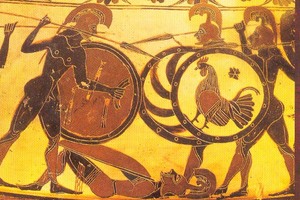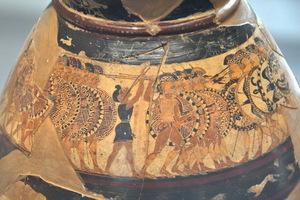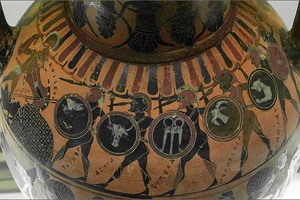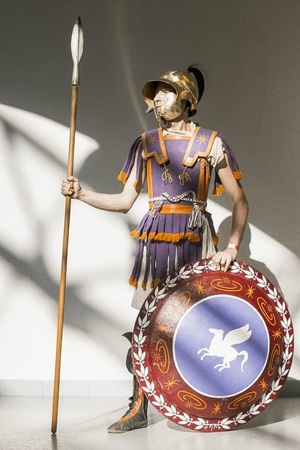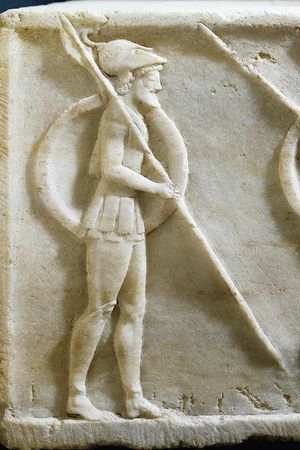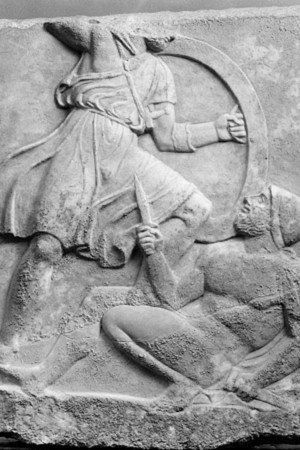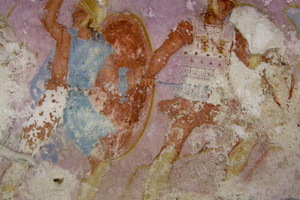Hoplite
Hoplite (Ancient Greek: ὁπλίτης) was an ancient Greek heavily armed infantry soldier, whose primary weapon was a long spear. The word derives from the name of the heavy round shield, hoplon (Ancient Greek: ὅπλον).
It should be noted that hoplites underwent significant changes in their equipment over the course of several centuries. Additionally, their equipment varied depending on their national affiliation. Hoplites were used in phalanxes by the Greeks, Macedonians, Carthaginians, Etruscans, Romans, and others. It is presumed that they first appeared in the Argos army. Hoplites served in the armies of Greek city-states and were essentially citizen-soldiers since it was the duty of a citizen of any free polis to serve in the military. Therefore, any gathering of citizens was essentially a gathering of soldiers—those currently serving or veterans. Hoplites were heavily armed Greek infantrymen. After the reforms of Solon in Athens, representatives of the most numerous class, the zeugitai, were required to serve in war equipped as hoplites. It is likely that in other Greek poleis, citizens with moderate wealth became hoplites during times of war, as it was their own responsibility to provide themselves with arms and equipment.
Hoplites dominated the battlefield for approximately four centuries, from the beginning of the 7th century BCE until the reign of Philip II (father of Alexander the Great). Hoplites formed the core of the classical phalanx.
Equipment
The equipment of a hoplite consisted of:
Reenactment
During the reenactmention of a hoplite, it is necessary to carefully select the era and region. Hoplites among the Greeks, Macedonians, and Etruscans differ significantly. The greatest attention should be paid to the choice of the helmet, which underwent the most significant changes over the time of the phalanx's existence in ancient armies. The next items that are most sensitive to the period are the armor and secondary weapons, such as the sword.
Related topics
Ancient Greece, Pileus, Linothorax, Bronze cuirass, Subarmalis, Spear, Hoplon, Tunic, Belt, Phalanx
Literature
Barry John. Wars of antiquity. From the Greco-Persian Wars to the Fall of Rome / Translated from English by T. Barakina, A. Nikitina, E. Nikitina, S.
Samchenko, T. Senkina, A. Cech. - Moscow: Eksmo, 2009. - 2nd ed. - 232 p.: ill. - Series "Military history of mankind". — ISBN 978-5-699-30727-2. Greek Hoplite // Military-historical almanac "Soldat" / Ed. by V. I. Kiselev. - Artemovsk: Military-historical club "Veteran"; Type. "Book", 2002. - 36 p.: 6 l. incl.
Cambridge History of the Ancient World, vol. III, part 3: The Expansion of the Greek World. VIII-VI centuries BC-Moscow: Ladomir Publ., 2007. (About hoplites: pp. 405-407, 532-533, 553-557, etc.). - ISBN 978-5-86218-467-9.
Connolly Peter. Greece and Rome. Encyclopedia of military history / Translated from English by S. Lopukhova, A. S. Khromova. - Moscow: Eksmo-Press, 2000. - 320 p.: ill. — ISBN 5-04-005183-2.
Herbert William Park. Greek mercenaries. Dogs of War of ancient Greece / Translated from English by L. A. Igorevsky. - Moscow: ZAO "Tsentrpoligraf", 2013. - 288 p. - ISBN 978-5-9524-5093-6.
Lavrenov S. Ya. Armies of Ancient Greece. - Moscow: OOO "AST"; Astrel, 2001. - 48 p.: ill. - "Military-historical series "Soldat"". — ISBN 5-17-004689-8.
Nefedkin A. K. Main stages of hoplite phalanx formation: military aspect of the problem // Bulletin of Ancient History. — 2002. — № 1.
Pechatnova L. G. Istoriya Sparta (period of Archaics and classics). - St. Petersburg: Humanitarian Academy, 2001. - 510 p. - ISBN 5-93762-008-9. Second Neil. Army of Sparta / Translated from English by A.V. Krasulina. - Moscow: OOO "AST"; Astrel, 2004. - 72 p.: ill. - Series "Elite troops". — ISBN 5-17-023262-4.

 Gallery
Gallery






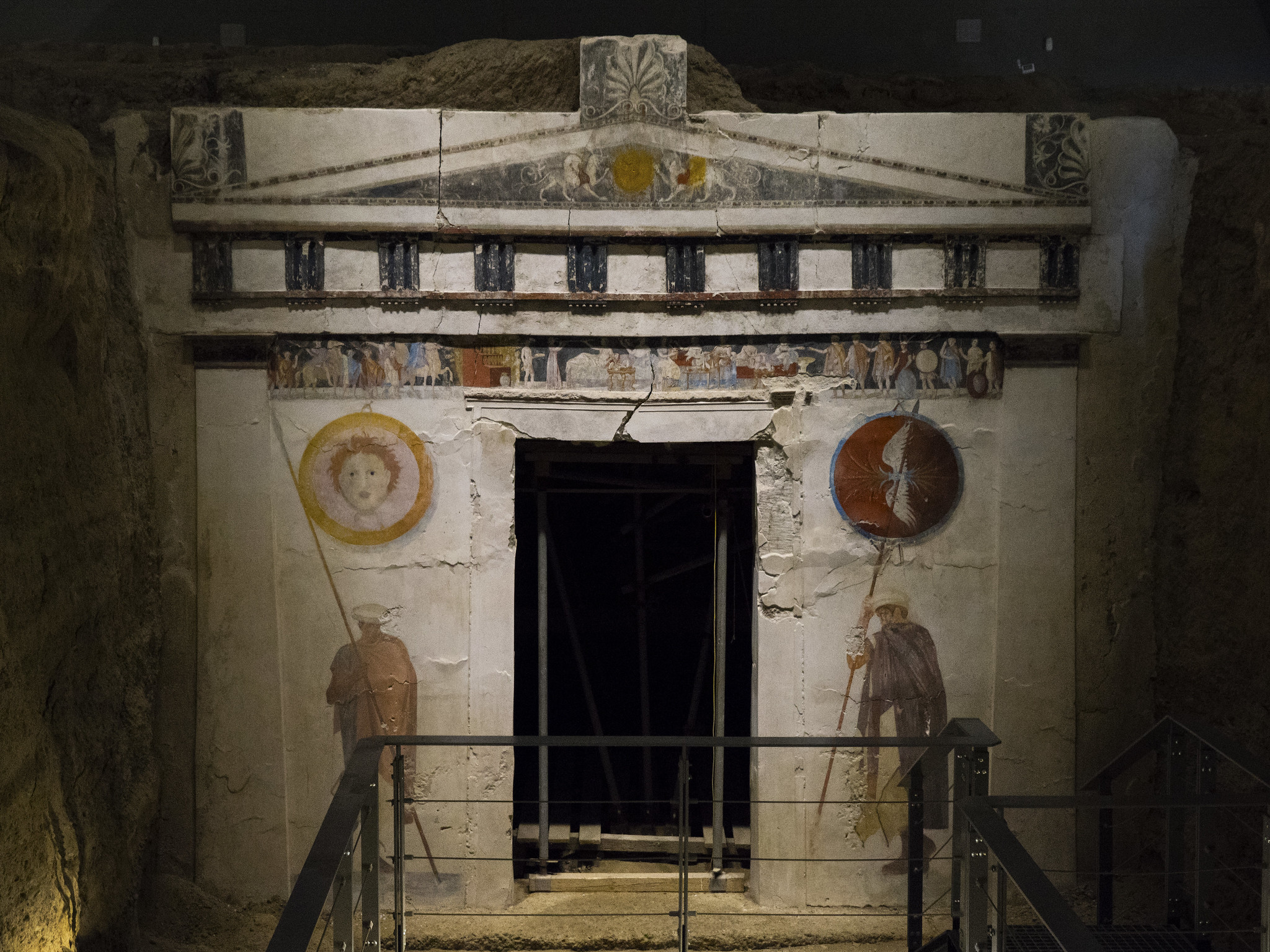 Entrance to the tomb of Agios Athanasios, late 4th century BC
Entrance to the tomb of Agios Athanasios, late 4th century BC
